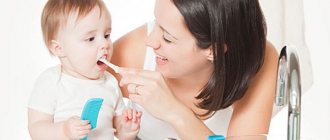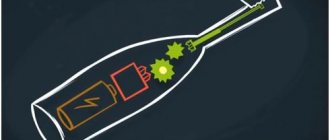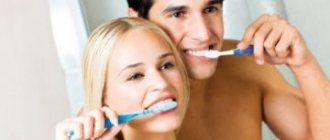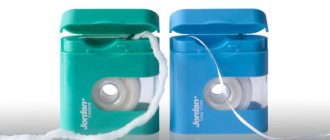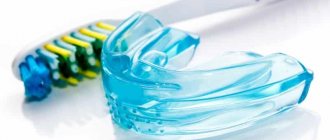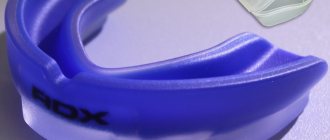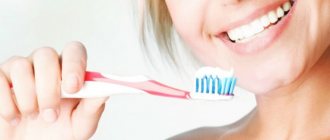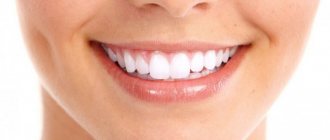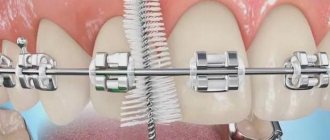Many orthodontists consider childhood to be the most appropriate age for correcting the position of teeth that have erupted and are just beginning to emerge, and for correcting malocclusion. This is due to the fact that the child’s jaw is still developing, so in a short time it is possible to correct existing defects and prevent the situation from getting worse. The most common reason for a child’s malocclusion is the lack of attention to this problem on the part of his mother. It is normal for a child to have a lower jaw that is smaller than the upper jaw, but during natural feeding this defect is usually corrected.
Many orthodontists consider childhood to be the most appropriate age for correcting the position of teeth that have erupted and are just beginning to emerge, and for correcting malocclusion.
The main causes of malocclusion:
- The hole in the nipple is too large (with artificial feeding). The child does not need to make any effort to obtain food and the jaw does not work or develop.
- Lack of roughage in the diet;
- Lack of minerals and vitamins in the body;
- Mouth breathing due to problems with blocked sinuses.
However, all this is not an insurmountable obstacle to getting a child a beautiful smile with straight teeth.
The most common reason for a child’s malocclusion is lack of attention from his mother.
Orthodontic equipment for teeth straightening and bite formation
There are several tools to straighten your teeth and form your bite:
- Trainers;
- Braces;
- Plates for teeth straightening.
Trainers
Most orthodontic devices designed to correct malocclusion eliminate the consequences of the pathological process, without excluding its cause. A dental trainer is a device that performs both tasks. Wearing trainers helps develop the jaw muscles, reduce pressure on the jaw bones, restore breathing through the nose and correct tongue position. Suitable for treating children from 5 years of age. They are especially effective when replacing baby teeth with permanent ones to correct their incorrect position. Wearing time is limited to night and a few hours during the day.
An impression is not required for production. Transparent silicone is used in different colors to make them more interesting for children to wear. Adapts well and does not affect diction. It is used for minor bite deviations, and can even replace braces if there are contraindications to wearing them.
First, trainers with soft silicone are used. Later, more stringent ones are used. Used for: deviations in tooth growth (location, direction, etc.), impaired swallowing function, pathologies of the oral cavity leading to chronic nasal congestion. They require daily care just like all devices.
Braces
Braces are special linings for each tooth, which are strung on a rigid metal arch. The main qualities of the arc:
- Strength;
- Elasticity;
- Availability of shape memory. No matter how the wire is bent during the treatment process, it tends to take its original shape.
Braces are the most common way to correct malocclusions. Starting from the age of 12 (the average period for the final eruption of permanent teeth), they can be installed in children. Braces are a non-removable device. They are attached to each tooth. Wearing them requires regular visits to your doctor, who determines and regulates the tension of the wire. When wearing braces, they are quite noticeable, and this affects the teenager’s behavior (they become more shy, tense and smile less often). The use of braces requires increased attention to oral hygiene (food gets stuck in the system) and imposes restrictions on the consumption of certain foods (hard and viscous). But despite the disadvantages, this is a very strong and durable design that allows you to eliminate many bite defects.
The use of braces requires increased attention to oral hygiene
Retainer
A retainer (in this case, a permanent retainer) is a thin wire made of the same material as the bracket arch. It is not an independent orthodontic device, but serves to prevent aligned teeth from returning to their original place. It is usually installed before removing braces, so we decided to mention it. It is not noticeable to others because it is attached to the inside of the jaw, where it is secured with dental cement that hardens under the influence of ultraviolet radiation. It is almost impossible to tear off, so there are no restrictions on eating hard and sticky foods.
Correct your bite or dental defect with invisible aligners Find out what it is
Device
Before you start adjusting the lock yourself, you need to figure out what the correction device consists of. Standard structure:
- Plastic base that follows the anatomy of the palate and jaws. Solid, durable, but not causing severe discomfort to the child. It comes in different shades, often bright, to appeal to children.
- Wire hooks, which in most cases are attached to the molars.
- Metal arc. It puts pressure on the rows and helps move them in the right direction.
- A screw with a hole located in the center. It is this that is activated and periodically tightened.
- Bright marking arrow indicating the direction for adjusting the device.
Plates for teeth straightening
Orthodontic plates are often called “braces” or “plates on the teeth.” This device is used to treat children under 15 years of age. Made individually for each child. It is attached to the outer surface, the inner part and can partially cover the sky. Made from soft or medium hard plastic and metal. The child takes food without any discomfort. There is no need for any special care for the plates.
Purpose:
- abnormal development of the bones of the jaw arches (narrowness of the jaw bone or disruption of its shape);
- the need to adjust the position of one or more teeth;
- movement of individual teeth;
- the presence of gaps between teeth (three and diastemas);
- the need to correct the narrowing of the palate;
- activation or slowdown of the jaw growth process;
- consolidation of results after using other orthodontic systems;
- preventing crowding;
- prevention of relapses of malocclusion, etc.
There is no need for any special care of the plates
Bite correction plate for the youngest children
To correct the bite in very young children (up to 3 years of age and older), special devices are used - Hinz vestibular plates (Dr. Hinz Dental) that look like a pacifier. Today, the Muppy brand portfolio includes several types of designs:
- Standard plastic – indicated for mouth breathing and thumb sucking.
- Vestibular plate with a visor - indicated for severe underdevelopment of the lower jaw against the background of bad habits.
- With wire flap – correction of open bite.
- The Muppy vestibular plate with a bead is worth buying if you have incorrect tongue position and diction defects.
All designs intended exclusively for primary occlusion have a red holder ring, and those designed for mixed occlusion have a blue one.
Classification of plates for teeth straightening
According to use, the equipment is:
- removable;
- non-removable.
Removable
– the simplest design, and is installed on children from 7 to 15 years old for short-term correction of teeth or bite. Fixed with hooks and worn daily. The duration of wearing is determined by the attending physician. They are most often made of plastic, but sometimes they come in complex designs that include springs and screws. The doctor periodically adjusts the device to obtain gentle pressure on the teeth. This achieves a positive therapeutic effect. The teeth are straightened and the bite is corrected. Such equipment is used when it is not possible to correct the defect using only a plate. Can be installed on both the upper and lower jaw.
Fixed (stationary)
– installed once using fixing brackets that prevent movement when eating, for up to two years. Monitoring and adjustment is carried out by the attending physician during a scheduled visit. It is most often used for young children and to correct serious developmental defects of the jaw apparatus.
Differences:
- stationary is more effective in correcting defects. More expensive than the removable version;
- removable, easy to remove at any time. Easier to care for.
According to the material of manufacture:
- metal;
- plastic.
Metal
– made of titanium-nickel or titanium-molybdenum alloy, which do not oxidize in the aggressive environment of the oral cavity. Outwardly it looks like a combination of wires and hooks. It can be either removable or non-removable. Used to treat children of all ages.
Plastic
– most of these plates are removable and are intended for treating children of middle and older age groups.
By purpose and device:
- Single-jaw – used to restore the dentition when it is shortened or narrowed, as well as to eliminate defects of individual teeth. Consist of a plate with adjustable orthopedic screws. Suitable for children of all ages.
- With retraction arch. Correct protrusion of teeth in a row. Based on the elastic properties of the arc. Suitable for correction on both jaws.
- With a hand-shaped process on an arch. Correct the position of individual teeth. The process puts pressure on the tooth and aligns its position. Can be installed on both the upper and lower jaw.
- With active pusher. Used to straighten the maxillary anterior incisors. The dentition is aligned with spring mechanisms for each uneven tooth.
- The Andresen-Goipl apparatus (activator) is a removable orthodontic device of combined action designed to correct occlusal defects. The activator makes it possible to fix the lower jaw in the required (extended) position, which gives impetus to its development. In this regard, the growth of the upper jaw is inhibited, the bite is disconnected, and the work of the facial and masticatory muscles returns to normal. Placing the inclined plane of the plate along the entire dentition makes it possible to move teeth in three planes - to the side, back and forward. This allows, with some design changes and additions to the activator, to successfully use it to correct not only distal occlusion, but also other deviations of occlusion.
- Bruckle's appliance is a removable device designed to correct deep mesial bite. It is installed only on the lower jaw, and, due to its design features, it has a positive effect on both dentitions.
- Frenkel apparatus - lip pads, brush shields, and other additional elements are installed on a metal frame. The device is attached simultaneously to both jaws and has a functionally targeted action that limits unnecessary muscle force. The use of the device promotes the normal development of the jaws, dental arches and rows. Open, distal and mesial bites are corrected, but the complexity and duration of production, as well as the high cost, do not contribute to its popularity.
The procedure for adjusting and installing the plate is simple and painless. At first, the child feels discomfort from the presence of the equipment in the mouth, but then he gets used to it.
Possible difficulties
During therapy, certain difficulties may arise, such as:
- The key fails or is lost. The part is very small, so it often happens that it gets lost. There's nothing wrong with that. How to tighten a dental plate for teeth if the key is lost? It can easily be replaced with any sharp object, for example, a sewing needle, knitting needle, or unfolded paper clip.
- Breakage of a metal part. This does not happen often, but when it does happen, it is with devices on the lower jaw due to the smaller size of the plastic base. In such a situation, you cannot do without the help of an orthodontist; you need to go to him as soon as possible. If you repair the record incorrectly, you will damage the device. Only a specialist can assess the scale of the problem and advise further course of action. In some cases, it is necessary not to repair, but to completely change the orthodontic structure.
Procedure for making and installing plates for teeth straightening
The selection and production of plates for correcting the bite is carried out only after examination by an orthodontist. The technique is as follows:
- A volumetric image of the jaw bone tissue (OPTG) is taken;
- Impressions of the jaws are taken;
- They are sent to a dental laboratory to produce the selected plate;
After the orthodontic equipment has been manufactured, the doctor installs it and explains to the parents and child how to wear it. The fixed structure takes a little longer to install than the removable one. The procedure for adjusting and installing the plate is simple and painless. At first, the child feels discomfort from the presence of the equipment in the mouth, but then he gets used to it.
Indications and contraindications for installing braces
The appointment and selection of the correct design is recommended by the doctor.
Treatment is prescribed in the following cases:
- Incorrect position of one or more teeth;
- Jaw bone development problem;
- Narrowing of the palate;
- Malocclusion;
- Teeth displacement after braces;
- Rare arrangement of teeth.
Orthodontists recommend installing plates for children under 12 years of age.
Often plates are placed on braces after treatment to secure the result as a retainer. You shouldn't be afraid of this.
In this age:
- the body grows and corrections occur quickly;
- children at this age are not so painfully worried about the installation of plates;
- children are more obedient and will not remove the plates often.
Plates are not installed in the following cases:
- untreated caries;
- gum disease;
- allergy to plate material;
- respiratory tract diseases;
- presence of stomatitis that requires treatment;
- abnormalities have been identified that require other treatment methods.
How long should you wear braces?
At the time of active formation of the dentition, the plates are changed approximately every six months. The duration of treatment is determined individually. Usually the defect is corrected in a year to a year and a half, further time is required to consolidate the result. Often plates are placed on braces after treatment to secure the result as a retainer. You shouldn't be afraid of this.
Caring for teeth straightening plates
In order for the equipment to work as expected, you need to perform simple operations. For this it is recommended:
- Clean the plate with a soft toothbrush;
- Use special cleaning gels (daily and weekly);
- Do not engage in active sports with the plate on;
- Store the equipment in a special container;
- Do not try to repair the plate yourself if you discover damage or deformation. You should consult your doctor;
- Treat the structure with a disinfectant solution. If the plate is removable, it is better to place it in the solution overnight;
- Remove the removable plates when eating;
- Before installation, rinse with warm boiled water;
- If the equipment design has a screw, it is recommended to lubricate it with vegetable oil so that it does not stagnate;
- Parents should ensure that the child does not remove the equipment at night;
- Teach your child how to tighten a screw in a plate;
- To avoid complications, periodically visit an orthodontist and follow his instructions;
- Carefully monitor oral hygiene during treatment (the presence of plates increases plaque in the mouth);
- If plaque or tartar is found on the plate, you should consult a doctor for cleaning.
The treatment is helped by a special massage that affects the gums and palate. By improving blood circulation, massage accelerates the healing and growth processes in the jaw area. This massage is performed while brushing your teeth.
What is better - braces or braces?
The plates are only effective for people under 15 years of age and may not help in some situations. And even at the age of 10-12 years, in some cases it is necessary to install braces. If the pathologies are minor and are in the initial stage, then it is enough to use plates.
Advantages:
- Possibility to remove if necessary;
- Easy to care for your oral cavity;
- Cheaper than braces.
Flaws:
- Often not effective enough;
- Long-term addiction.
Advantages of braces:
- Continuous action on teeth;
- Quick addiction;
- A larger number of defects can be eliminated simultaneously.
Flaws:
- Difficulties in caring for the oral cavity;
- High cost for the entire range of services.
Benefits of this treatment method
The plates enjoy consistently high popularity and are unlikely to go out of use in the foreseeable future because:
- They are light, comfortable, non-traumatic.
- They are very easy to care for from a hygienic point of view.
- They look quite aesthetically pleasing and do not cause negative emotions even in the most suspicious patients.
- Their installation and correction requires a minimum of time and effort.
- They cause virtually no pain or inconvenience to patients.
- Their cost is always kept at a reasonable level and is accessible to the widest segments of the population.
Reviews of plates for teeth straightening
Looking through the reviews from parents, it can be noted that they are all positive. Children quickly get used to wearing the equipment. All dental defects are corrected quickly. It cannot be said that for all children the operation with the installation of plates is completely painless, but if everything is chosen correctly, the inconvenience quickly passes.
Dentists also respond well to the plates. Some believe that in adults, correcting defects with plates is even more convenient. For them, this is done even longer, once, but in children, as the jaw grows, the correction plates need to be changed.
Summing up
Children's teeth are not only a cheerful smile. It is also an important link in the digestive tract. Depending on the quality of chewing food, the further process of digestion also depends. Disease of the teeth and gums often leads to inflammation of other organs. It is necessary to monitor the condition of a child’s teeth from a very early age. Replacing baby teeth with permanent ones should be natural. Often, an extracted baby tooth causes the molar to erupt in the wrong place, and as a result, the need for orthodontic treatment with plates or braces. Doctors say: “It is better to prevent a disease than to treat it.”
The appearance of malocclusion or crooked teeth must be corrected as early as possible. To identify abnormalities in a timely manner, it is recommended to bring your child for examination to the dentist at least twice a year, starting from the age of one.
Parents should ensure that their child learns to brush his teeth well as early as possible and help him do it correctly.
Periodically examine his oral cavity and if you notice a brown or white spot on his teeth, immediately contact a dentist. Currently, doctors have completely painless ways to treat caries.
Useful tips
As we have already said, the child will have to get used to the plate for some time. In the first 1-2 days, the baby may feel pain and discomfort, his speech may be impaired, and salivation may increase. And, of course, the child will want to remove the record and begin to act up.
Typically, all adaptation symptoms subside 3-7 days after installation and the child ceases to notice the device in the mouth.
It is important for parents to ensure that the child does not try to remove the foreign device from the mouth. Try to distract your child from unpleasant sensations - play, go for a walk, watch an interesting colorful cartoon together. A few days will “fly by” unnoticed and the child will get used to his new smile assistant.
After installing the plate, special attention should be paid to caring for the baby’s oral cavity. Be sure to brush your teeth twice a day (remove the plate during this period) and thoroughly clean the structure itself.
We hope that very soon your child will show off with a luxurious, even smile. And so that children are happy to brush their teeth and enjoy each such procedure, choose for them a pleasant and effective toothpaste, such as Asepta Kids, a gel paste for children from 4 to 8 years old. This reliable product for daily protection against caries is designed taking into account the structural features of children's enamel.
Fluoride-free gel paste carefully protects teeth from caries, cares for baby’s gums, and prevents the development of inflammation in the oral cavity. The product does not contain fluoride, parabens, sodium lauryl sulfate or antiseptics, and the bright taste of “tutti-fruit” will make brushing your teeth very pleasant for your child.
Sources:
- Study of the clinical effectiveness of the use of therapeutic and prophylactic agents of the ASEPTA series in the treatment of inflammatory periodontal diseases in children and adolescents (I.V. Klimova) Irina Vladimirovna Klimova, Candidate of Medical Sciences, Associate Professor of the Department of Pediatric Dentistry, Novosibirsk State Medical University. Department of Pediatric Dentistry, Novosibirsk State Medical University.
- The use of drugs from the Asepta line in the complex treatment of inflammatory periodontal diseases (N.V. Berezina E.N. Silantyeva S.M. Krivonos, Kazan State Medical Academy. Kazan.) N.V. BEREZINA, E.N. SILANTIEVA, S.M. KRIVONOS Kazan State Medical Academy
- Clinical experience in using the Asepta series of products Fuchs Elena Ivanovna Assistant of the Department of Therapeutic and Pediatric Dentistry State Budgetary Educational Institution of Higher Professional Education Ryazan State Medical University named after Academician I.P. Pavlova of the Ministry of Health and Social Development of the Russian Federation (GBOU VPO RyazSMU Ministry of Health and Social Development of Russia)
